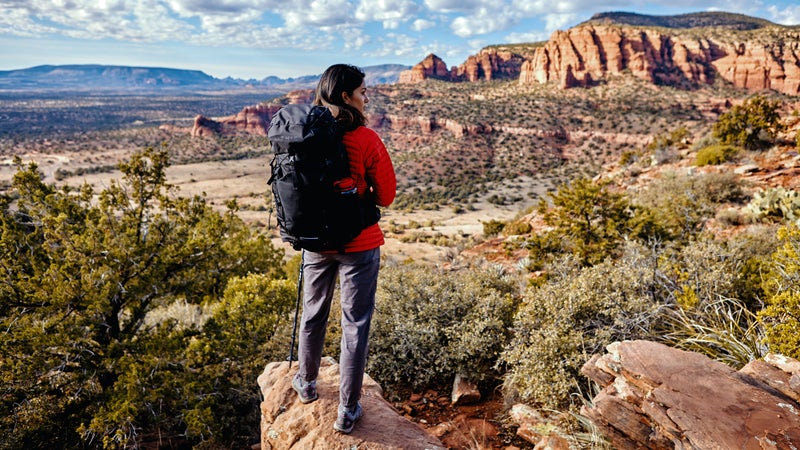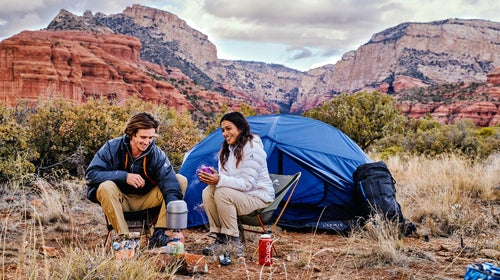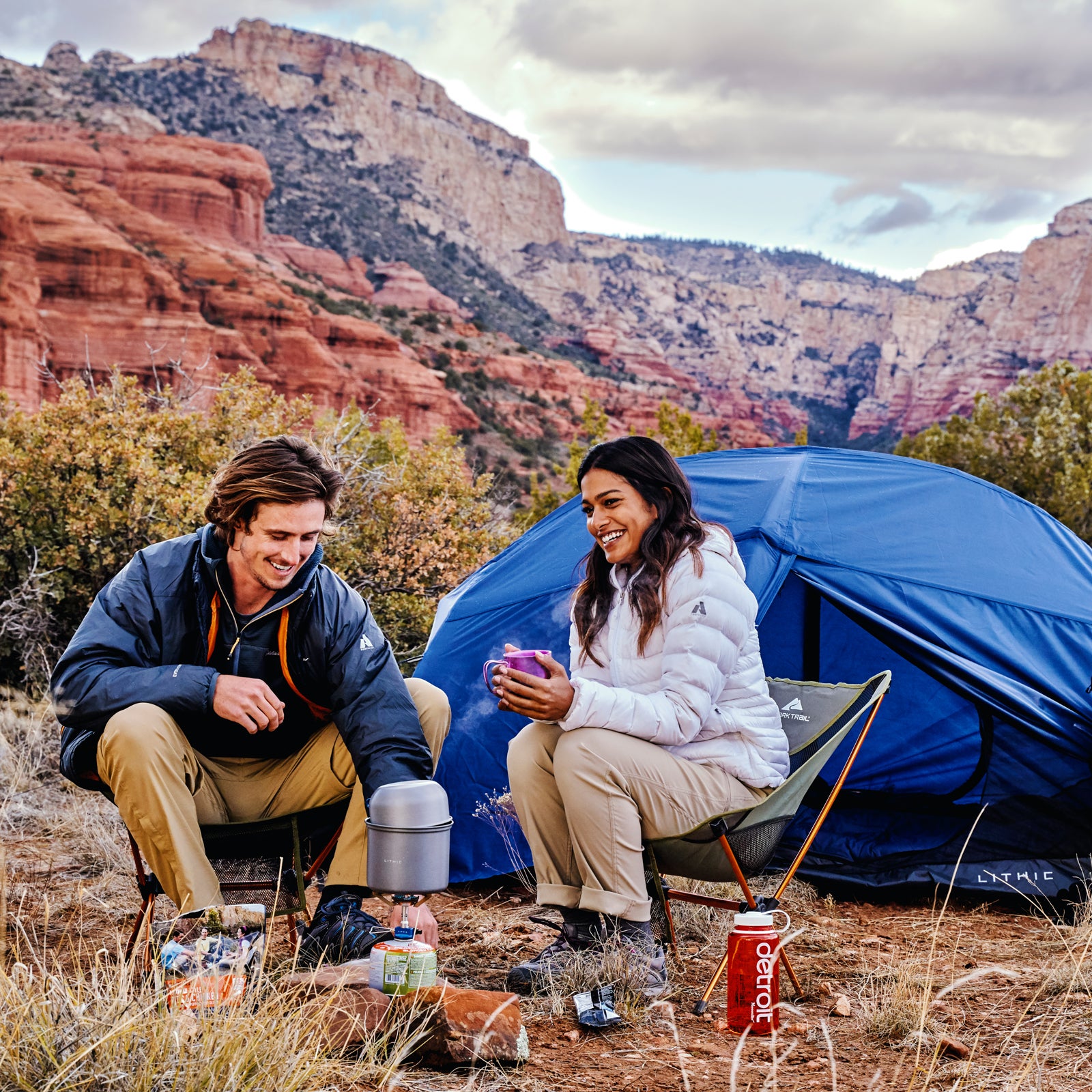HereÔÇÖs a surprising stat: according to Walmart, the company sells two million tents and three╠řmillion sleeping bags each year. If those figures are accurate, it likely makes Walmart the largest retailer of tents and bags in the nation. But, the majority of those sleeping bags cost less than $30 and are intended for car camping or other casual uses.╠ř
Walmart is betting that some of the customers who buy such╠řproducts are ready to ramp into lighter backcountry gear and deepen their connection with the outdoors. Today╠řthe chain announced the launch of Lithic, ╠řpriced as much as 40 percent lower than similar products on the market. ItÔÇÖs also releasing Allforth, a ╠řthat had a soft launch╠řlast fall, with prices ranging from $15 to $35 and availability in larger sizes (up to 3XL for men and 2XL for╠řwomen). The idea, says Eoin Comerford, general manager of e-commerce for WalmartÔÇÖs outdoor division, is to increase outdoor participation by offering more inclusive apparel and lowering the cost barrier to backcountry use. ÔÇťThe outdoor industry will not grow without attracting a more diverse customer base, and diversity will not happen without inclusivity,ÔÇŁ he says.
Lithic gear ranges from one-to-three-person tents╠řto down sleeping bags to stoves. Judging by the gear ║┌┴¤│ď╣¤═° has tested, itÔÇÖs of similar quality to products offered by specialty manufacturers. Lithic is already available online and currently in about 50 Walmart stores, all west of the Mississippi, as well as in all 11 Moosejaw shops, the specialty retailer that Comerford founded and Walmart purchased in 2017 (Comerford remains the CEO). Allforth apparel consists of 15 models of shirts, shorts, and pants made of performance fabrics and featuring technical specs like venting and zip-off legs. It is available exclusively online.

WalmartÔÇÖs foray into backpacking gear has the potential to impact outdoor retailers and manufacturers that have been hit hard by COVID-19 store closures and the deepening recession. Mindful of that, and of WalmartÔÇÖs failed and controversial launch of an online specialty outdoor gear shop╠řin 2018, Comerford points out that╠řÔÇťthe vast majority of Walmart customers who will buy Lithic gear have never walked into a specialty retailerÔÇŁ and are therefore not competition for those shops, nor for specialty brands.╠ř
Furthermore, he says, the new Walmart brands should help create new customers for specialty retailers and manufacturers╠řby providing affordable entry gear for╠řbackcountry pursuits. ÔÇťThe most likely source of beginner backpackers are car campers who already know and enjoy life in a tent,ÔÇŁ Comerford wrote in an . ÔÇťThis trend is reflected in the most recent ╠řthat shows car camping is becoming more diverse. Non-white active camper householders increased from 12 percent of the total in 2012 to 31 percent in 2018.ÔÇŁ╠ř
In our reporting, we havenÔÇÖt encountered industry backlash that contradicts this. In fact, says Rich Hill, president of the independent specialty retailer group Grassroots Outdoor Alliance, LithicÔÇÖs customers donÔÇÖt overlap with those of his trade group. ÔÇťWe have to embrace lower-cost gear like this, because it is how most people gain entry into outdoor adventure,ÔÇŁ he says. ÔÇťIdeally, every shop would carry some very low-cost options. Then, once the customer is ready to upgrade, the shop can sell them a sleeping bag that stuffs to half the size.ÔÇŁ
However, the quality of this new gear is better than most will expectÔÇöthe result of being designed by Moosejaw employees and manufactured╠řby some of the same partners that outdoor-retailer stalwarts use, Comerford says╠ř(though he╠řdeclined to name which ones).╠ř
We tested the ╠ř($129).╠řAt 35.5 square feet and weighing 5.42 pounds, it has specs, materials, and structure comperable to something like MSRÔÇÖs Elixir, but it costs $121 less. The Lithic tent stood up fine to 30-mile-per-hour gusts╠ř▓╣▓ď╗ň includes a separate footprint and top-shelf aluminum stakes. On our sample, though, one of the hooks that helps hang the inner mesh tent body from the poles was mistakenly sewn hanging into the tent bodyÔÇÖs interior.╠ř
The ╠ř($109) features a 35-degree╠řrating and 600-fill down stuffing╠ř▓╣▓ď╗ň weighs 1.87 pounds. By comparison, the North FaceÔÇÖs Gold Kazoo has the same temperature rating and╠řweighs 1.81 pounds, albeit with╠řa slightly more lofty 700-fill down╠ř▓╣▓ď╗ň a few design niceties, like a vaulted footbox and a draft collar. But at $240, the North Face bag is also more than twice the price.
We didnÔÇÖt test any Allforth gear, but online reviews following the companyÔÇÖs soft launch have largely been favorable, and the prices are impressively low. ╠ř($35), with zip-off legs and two-way stretch fabric, is similar to the╠řSilver Ridge Convertible pant from Columbia and retails at close to half the price. The technical shirts also offer comparable savings.╠ř
Walmart can build gear more cheaply because, as the , it can exert considerable pressure on material suppliers and manufacturers to lower their prices. The company also likely takes less margin on each product than specialty manufacturers, says Comerford, and, of course, itÔÇÖs cutting out the middle man by manufacturing its╠řown brands.
ÔÇťWe have to embrace lower-cost gear like this, because it is how most people gain entry into outdoor adventure,ÔÇŁ╠řsays Rich Hill, president of the Grassroots Outdoor Alliance.
Walmart isnÔÇÖt the only retail behemoth to recently enter the American outdoor industry╠řboasting such prices. In 2019, European outdoor retail giant Decathlon launched an online presence and two physical locations in the U.S. in a bid to capture the lower end of the market. Like Walmart, Decathlon manufactures its own gear, enabling the company╠řto boast astronomically affordable prices. (The brand╠řoffers an╠ř and a ╠řfor just $149 each.) However, it has yet to make a sizeable dent in the outdoor world and has not yet made good on its plans to open more stores outside the San Francisco Bay Area.╠ř
Of course, Walmart already has 4,756 store locations in the United States╠ř▓╣▓ď╗ň legions of customers who buy inexpensive camping gear there. But will those customers be interested in making the switch to products that are both pricier and more pared down? LithicÔÇÖs prices╠řÔÇťseem really cheap to us,ÔÇŁ says Hill, ÔÇťbut those are high-dollar items for Walmart.ÔÇŁ In an effort to get the products in front of new users, Walmart decided to place them in stores that are relatively close to backcountry destinations, including Hood River, Oregon;╠řTucson, Arizona; and Gallup, New Mexico. The products, says Comerford, are being stocked as a collection, featured on the endcaps of╠řaisles.╠ř
As for ComerfordÔÇÖs goal of getting the gear into the hands of a more diverse customer base, those locations seem like a mixed bag. Southwest and Intermountain West locations certainly have a considerable number of Latino customers, but of the 50 Walmart locations, only the three Phoenix stores would seem serve truly ethnically diverse populations.
Comerford points out, though, that the gear is available in Moosejaw shops across the upper Midwest, including Chicago and Detroit, and online.╠ř
Jos├ę Gonz├ílez, the founder emeritus of Latino Outdoors, says that his own introduction to outdoor brands was through Walmart, where he found╠řÔÇťaffordable and accessible gear.ÔÇŁ He says that Lithic and Allforth are╠řÔÇťa great start in getting more diverse populations outdoors,ÔÇŁ though he personally wouldnÔÇÖt buy the products because of the companyÔÇÖs history of and .
Gonz├ílez╠řpoints out that charitable giving tied to the Lithic and Allforth products could go a long way toward╠řrepairing that reputation. So could donating a certain percentage of product╠řrevenue to nonprofits that specialize in loaning gear to new and minority users, which would also help the company market its gear to its target consumers. (Organizations like and the Appalachian Mountain ClubÔÇÖs have large gear libraries that loan gear to urban populations new to camping.)
Garrett Dempsey, who runs a gear library for Detroit Outdoors, says that while some of his clients donÔÇÖt shop at Walmart for ethical reasons, many others shop there regularly. ÔÇťIÔÇÖm not going to tell a parent without considerable means that they shouldnÔÇÖt buy suitable Walmart gear for their child,ÔÇŁ he says. ÔÇťIf this gear is well priced and accessible, it absolutely would help lower the cost barrier for some folks.ÔÇŁ
Even beyond the debate over cheap gearÔÇöwhether increased access for all outweighs the╠řlabor abuses all too common in the garment industryÔÇöthere is one unequivocal bright spot: WalmartÔÇÖs inclusive marketing strategy. AllforthÔÇÖs models represent a wide range of skin colors, ages, and body types. Gonz├ílez notes╠řthat Allforth surpasses even REIÔÇÖs efforts to feature diverse models in that it╠řincludes a wider range of ages. ÔÇťItÔÇÖs positive that I can see people here who look like my parents,ÔÇŁ he says. ÔÇťA lot of communities of color do spend money on outdoor products. ItÔÇÖs important to acknowledge that.ÔÇŁ


